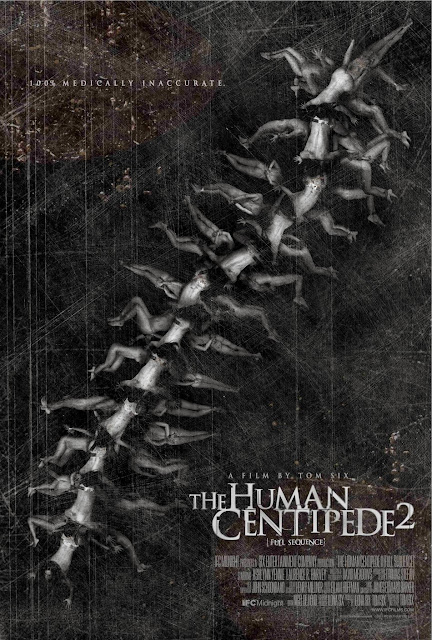Storyline:
Martin is a mentally disturbed loner who lives with his mother in a bleak housing project. He works the night shift as a security guard in an equally grim and foreboding underground parking complex. To escape his dreary existence, Martin loses himself in the fantasy world of the cult horror film The Human Centipede (First Sequence), fetishizing the meticulous surgical skills of the gifted Dr. Heiter, whose knowledge of the human gastrointestinal system inspires Martin to attempt the unthinkable.
Martin is a mentally disturbed loner who lives with his mother in a bleak housing project. He works the night shift as a security guard in an equally grim and foreboding underground parking complex. To escape his dreary existence, Martin loses himself in the fantasy world of the cult horror film The Human Centipede (First Sequence), fetishizing the meticulous surgical skills of the gifted Dr. Heiter, whose knowledge of the human gastrointestinal system inspires Martin to attempt the unthinkable.
Here's the thing about the "Human Centipede" movies: when you hear the premise of the films, that moment of "oh, gross, really?" is about as strong an impact as the films will ever have.
The first film is really all about the art of the misdirect. You hear the set-up and you dread the experience of actually seeing what it's about, and then when you do see it, it's fairly tame. Things are suggested. It's terrifying in concept more than execution. We didn't care for the first film, but we respect the way it's put together and the general filmmaking skills. Tom Six had a good sense of how to make you feel like you were going to see the end of the world, and the whole thing is so blatantly gleeful about being childish and ridiculous that it's hard to be upset by it. We would never call the first film a good film, but it's a well-made film that we don't think is interesting. It's not worthless. It's not trash. It's just provocation with no weight behind it, and it left us cold.
Is Tom Six a filmmaker? Is Tom Six a storyteller? No, at this point, you’ll have to conclude he is neither of these things. What he is represents something maybe more honest, more pure: he’s a provocateur. In making “The Human Centipede: First Sequence,” Six took a memorably deranged subject of medical dubiousness and turned it into a taut, often surprisingly funny shock fest, notable for its actual restraint considering the risible content. Lambasted for being a one-joke (one-gag?) premise, Six took advantage of a memorably deranged turn by Dieter Laser to produce a sterile, cold minor classic within the horror genre.
For a sequel, however, Six clearly read the reviews. The sick madman that he is, he noted the few positive marks the picture drew and decided to elaborate on the gruesomeness of his core idea, the visual of human beings surgically attached to create one single digestive system. As a result, he responded to the praise regarding his considerable lack of gore on that first film by doubling down and, in several ways, catering to the sickos in the audience. You’ve got to admire this guy’s subversion of expectation.
What results is “The Human Centipede Part II: Full Sequence,” and were it not in black and white, you could argue for the film reaching a top spot in the all-time gross-out pantheon. As is, the color scheme only keeps the picture in the top (bottom?) 10, as the film is mercifully dwarfed by the stateside arrival of “A Serbian Film” months ago. This cannot be emphasized enough: 'Full Sequence' might very well make you sick to your stomach, no matter how much experience you have as a gorehound. Where the first film pulled, this one pushes, to an unpleasant degree.
Taking the meta approach, 'Full Sequence' concerns a fan of the first picture. Cannily calling out his audience, Six cast Laurence Harvey as Martin, a 'Human Centipede' diehard, a parking lot attendant who seems to have the adventures of Dieter Laser and friends on a constant loop. Martin is short and stout, with a bulbous potbelly that almost looks like a freakish prosthetic. Hacking and wheezing with asthma in place of actual dialogue, he is emboldened by the original movie to create his own freakish multi-part monstrosity. Instead of three participants, however, Martin captures a good dozen victims, ready to unite them as one nightmarish appendage. The film takes great pains to illustrate how Martin isn’t nearly as clinical as the maniacal Dr. Heiter of the first film: we’ll just say stitches are replaced by staples this time around, and you can figure the rest.
Full Sequence' is, all bodily fluids taken into account, a memorably vivid visual experience. Six knows his way around a great shot, and the black-and-white photography is stark and transfixing, creating images that worm their way into your brain not only for their grotesqueries, but because of their quiet, sickening grace. Even with the much smaller budget and somewhat sloppier feel, 'Full Sequence' is well-deserving of a few eye-catching screen grabs. Six deserves kudos for also discovering Harvey, a Mad Magazine sketch of a pervert, with bug eyes that make Peter Lorre look like Anton Yelchin. And it’s uncomfortably funny when Six interrupts a three-way sex session between a female prostitute, an overweight, cursing slob, and Martin’s sadistic and supernaturally calm doctor -- Six knows how to populate his movie with unforgettable faces.
The problem with 'Full Sequence' is that it's so meta that it can’t exist on its own. After silently (and mesmerizing) introducing us to the wordless Martin, he goes about recreating the Centipede with his 12 victims. A thoroughly graphic and unpleasant section of the film, one that will leave viewers gasping for breath, these moments are robbed by their potency because Martin is serving a higher god, specifically Six himself (somewhat disappointingly, Six does not appear as himself). This is emphasized with a groaner of an ending, one that puts a damning punctuation mark on Six’s feelings towards his audience, his detractors and censorship, but also serves to illustrate “The Human Centipede: First Sequence” as some unforgettable totem of deprived filmmaking, when in fact it’s not in league with several of the 1980s “video nasties.”







No comments:
Post a Comment